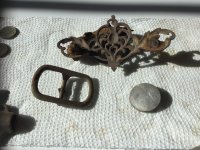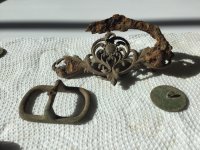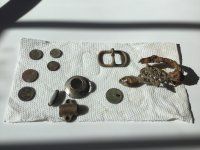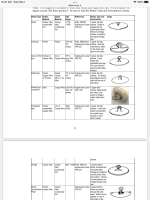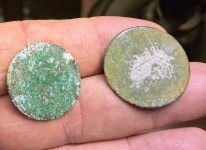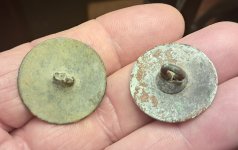Geologyhound
Well-known member
I had to go wading through the snow, but I wanted to get out once in January. I went back to a spot with an old house and garbage dump. I found a buckle and what appears to be a drawer pull for an old curved front dresser. But, I am scratching my head over what appears to be an alpha shank flat button. This is between the size of a quarter and a 50 cent piece, and is thinner than a coin. The back might have had a slightly raised rim. The back is green just like an old Indian head penny and does not appear to have any writing. The alpha shank would suggest a manufacture date of the late 1700s to early 1800s. But, the front has scratched plating (worn around the edges) which looks almost likes stainless steel.
I don’t know if anything was ever plated in stainless. The alpha shank would be way too early. There would’ve been chrome steels in the early 1800s but I don’t know that early chrome steel would resist corrosion for this long.
I suppose this could be silver plate, but the shade just appears to be a little off. I suppose it could have something to do with how it has weathered. Also, the front is scratched up which would indicate it has to be a fairly thick plate or else I would’ve expected it would’ve flaked off by now.
I wondered if it could be something more modern, but the patina on the back and the corrosion pits on the shank just looks ”old”. I also wondered if it could be part of a two-piece button, but I don’t know why they would put a different metal on the front if it would just be covered.
Any ideas?
I don’t know if anything was ever plated in stainless. The alpha shank would be way too early. There would’ve been chrome steels in the early 1800s but I don’t know that early chrome steel would resist corrosion for this long.
I suppose this could be silver plate, but the shade just appears to be a little off. I suppose it could have something to do with how it has weathered. Also, the front is scratched up which would indicate it has to be a fairly thick plate or else I would’ve expected it would’ve flaked off by now.
I wondered if it could be something more modern, but the patina on the back and the corrosion pits on the shank just looks ”old”. I also wondered if it could be part of a two-piece button, but I don’t know why they would put a different metal on the front if it would just be covered.
Any ideas?




